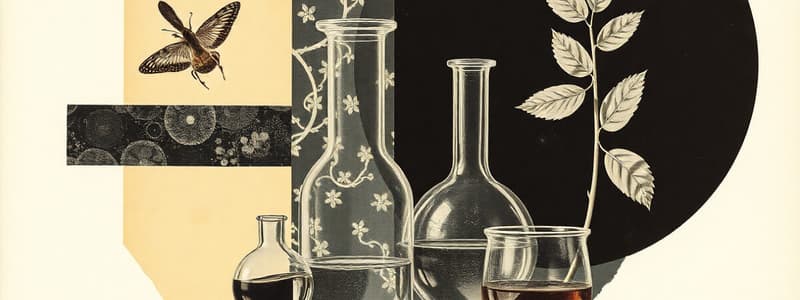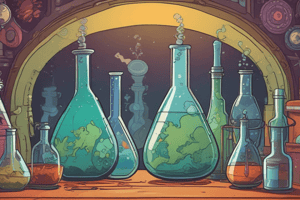Podcast
Questions and Answers
In the scientific method, a(n) ______ is a testable statement or educated guess that attempts to explain an observation.
In the scientific method, a(n) ______ is a testable statement or educated guess that attempts to explain an observation.
Hypothesis
A(n) ______ group is a vital part of an experiment because it provides a baseline measure to compare against the experimental group, ensuring that any observed effects are due to the variable being tested.
A(n) ______ group is a vital part of an experiment because it provides a baseline measure to compare against the experimental group, ensuring that any observed effects are due to the variable being tested.
Control
[Blank] data involves descriptive characteristics that cannot be easily measured numerically, while quantitative data involves numerical measurements.
[Blank] data involves descriptive characteristics that cannot be easily measured numerically, while quantitative data involves numerical measurements.
Qualitative
When using lab equipment to measure volume, like a graduated cylinder, it's important to read the ______ at eye level to ensure an accurate measurement.
When using lab equipment to measure volume, like a graduated cylinder, it's important to read the ______ at eye level to ensure an accurate measurement.
A ______ control demonstrates what a positive result looks like, while a negative control confirms what a negative result should be.
A ______ control demonstrates what a positive result looks like, while a negative control confirms what a negative result should be.
A ______ is a complex carbohydrate composed of many monosaccharides linked together and can serve as a form of energy storage or structural support in organisms.
A ______ is a complex carbohydrate composed of many monosaccharides linked together and can serve as a form of energy storage or structural support in organisms.
The ______ test is used to detect the presence of simple sugars, indicated by a color change from blue to green, yellow, orange, or red when heated.
The ______ test is used to detect the presence of simple sugars, indicated by a color change from blue to green, yellow, orange, or red when heated.
[Blank] are molecules with a polar head and a nonpolar tail, allowing them to stabilize mixtures of oil and water
[Blank] are molecules with a polar head and a nonpolar tail, allowing them to stabilize mixtures of oil and water
Flashcards
Hypothesis
Hypothesis
A testable explanation for a phenomenon.
Control Group
Control Group
A group in an experiment that does not receive the treatment.
Theory
Theory
An explanation of the natural world that is supported by a large body of evidence.
Qualitative vs. Quantitative Data
Qualitative vs. Quantitative Data
Signup and view all the flashcards
Positive Control
Positive Control
Signup and view all the flashcards
Negative Control
Negative Control
Signup and view all the flashcards
Active vs. Passive Transport
Active vs. Passive Transport
Signup and view all the flashcards
Diffusion vs. Osmosis
Diffusion vs. Osmosis
Signup and view all the flashcards
Study Notes
- Study notes for Bio 103 lab test
Scientific Method
- Key concepts include observation, question, hypothesis, prediction, and experiment
- A hypothesis can be formed if given a scenario
Controls and Variables
- Understanding the roles of controls, including the importance of a control group
- A control group is essential for comparison to gauge the effect of the independent variable
Theories
- Understanding the definition of a scientific theory
Qualitative vs. Quantitative Data
- Qualitative data deals with descriptions, Quantitative data deals with numbers
Metric Conversions
- Performing metric conversions
Tools for Volume Measurement
- Identify graduated cylinders and beakers
- Accurately reading liquid volume using these tools
Thermometer Use
- Reading a thermometer to measure temperature
Positive and Negative Controls
- Positive control demonstrates what a positive result looks like
- Negative control demonstrates what a negative result looks like
Mono, Di, and Polysaccharides
- Monosaccharides, disaccharides, and polysaccharides differ in the number of sugar units
- Examples of monosaccharides exist
- Location of various polysaccharides and their importance to humans can be determined
Benedict's Test
- Used to test for reducing sugars
- A positive result is indicated by a color change
Starch Test
- Process of testing for starch
- Changes that appear when starch is present
Lipids
- Familiarize yourself with major lipids
- Knowing if they are polar or non-polar
Emulsifying Agents
- Definition of an emulsifying agent and how one works
Sudan Test
- Process of a Sudan test
- Expected results of a Sudan test
Proteins
- An amino acid is the building block of proteins
- A polypeptide is a chain of amino acids
- Hydrogen bonds are important for protein structure
Table 2.1
- This chart on page 24 of the manual contains key data
Microscope Parts
- Labeling the parts of a microscope based off Figure 3.1 on page 42 of the manual
Total Magnification
- Calculating total magnification with different lenses
Parfocal
- Understanding and defining what a parfocal lens is
Working Distance
- Working distance and how it changes with magnification
Cell Theory
- Understanding the concepts of cell theory
Linnaeus System
- Knowledge of the Linnaeus system of classification
Prokaryotes vs. Eukaryotes
- Differences between prokaryotic and eukaryotic cells
Autotrophs vs. Heterotrophs
- Differences between autotrophs and heterotrophs
- Referring to the table on page 53 of the lab manual for information on different kingdoms
Bacteria
- Understanding the meaning of bacillus, coccus, and spirilla in terms of bacteria
Eukaryotic Cells
- Functions of the major organelles in a Eukaryotic cell
Plasmids and Nucleoids
- Identifying what a plasmid is and who has them
- Understanding what a nucleoid is
Identifying Organisms
- Identifying various organisms under a microscope
- Classifying them as animals, plants, prokaryotes, or eukaryotes
- Identifying structures such as pseudopods, flagella, and cilia
- Distinguishing between single-celled and multicellular organisms
- Identifying sexual or asexual reproduction in fungi
- Identifying plant cell walls
Active vs. Passive Transport
- Understanding active and passive transport, diffusion, and osmosis
Diffusion
- Describing diffusion based on temperature using graphical representations of diffusive speed
Dialysis Tubing
- Understanding that dialysis tubing is a semi-permeable membrane
- Understanding the terms isotonic, hypertonic, and hypotonic in relation to solutions
Studying That Suits You
Use AI to generate personalized quizzes and flashcards to suit your learning preferences.




